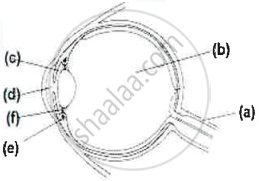Advertisements
Advertisements
प्रश्न
Name the following:
Capacity of the eye to focus at different distances.
उत्तर
Power of accommodation
संबंधित प्रश्न
Write the function of the following part of the human eye: Cornea
Night birds have ______ cones than rods in their eyes.
What happens to the size of pupil of our eye (i) in dim light (ii) in bright light?
Refraction of light in the eye occurs at:
(a) the lens only
(b) the cornea only
(c) both the cornea and the lens
(d) the pupil
How does the eye change in order to focus on near or distant objects?
(a) The lens moves in or out
(b) The retina moves in or out
(c) The lens becomes thicker or thinner
(d) The pupil gets larger or smaller
An object is moved closer to an eye. What changes must take place in the eye in order to keep the image in sharp focus?
A man driving a car can read a distant road sign clearly but finds difficulty in reading the odometer on the dashboard of the car. Which of the following statement is correct about this man?
(a) The near point of his eyes has receded away.
(b) The near point of his eyes has come closer to him.
(c) The far point of his eyes has receded away.
(d) The far point of his eyes has come closer to him.
What are the advantages of having two eyes instead of just one?
Sometimes you remember a vivid picture of a dream you saw. What is the role of your eyes in this experience?
Name the muscles of the eye responsible for the power of accommodation.
Define the following:
Power of accommodation
Differentiate between:
Vitreous humour and Aqueous humour.
Name the following:
The part of the eye responsible for change in the size of the pupil.
Name the capacity of the eye lens to change its focal length as per need.
Write an Explanation.
Power of accommodation
In a myopic eye, the image of the object is formed
Given below is a cross section of the human eye. Match the structures marked (a) to (e) with their correct functions:
Example: (f) - 6. Holds the lens in position
| Cross section of Human Eye | Functions | |
 |
1. | Protects retina |
| 2. | Regulates the size of the pupil | |
| 3. | Alters the shape of the lens | |
| 4. | Keeps the lens moist | |
| 5. | Transmits nerve impulses to brain | |
| 6. | Holds the lens in position |
Name the following:
Place of best vision in the retina of the eye.
The thin, transparent extension of sclerotic layer found in front of the lens is ______.
Write the main functional activity of the following structure.
Choroid
